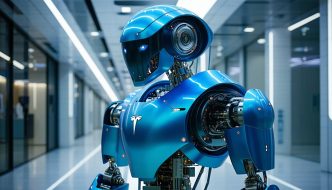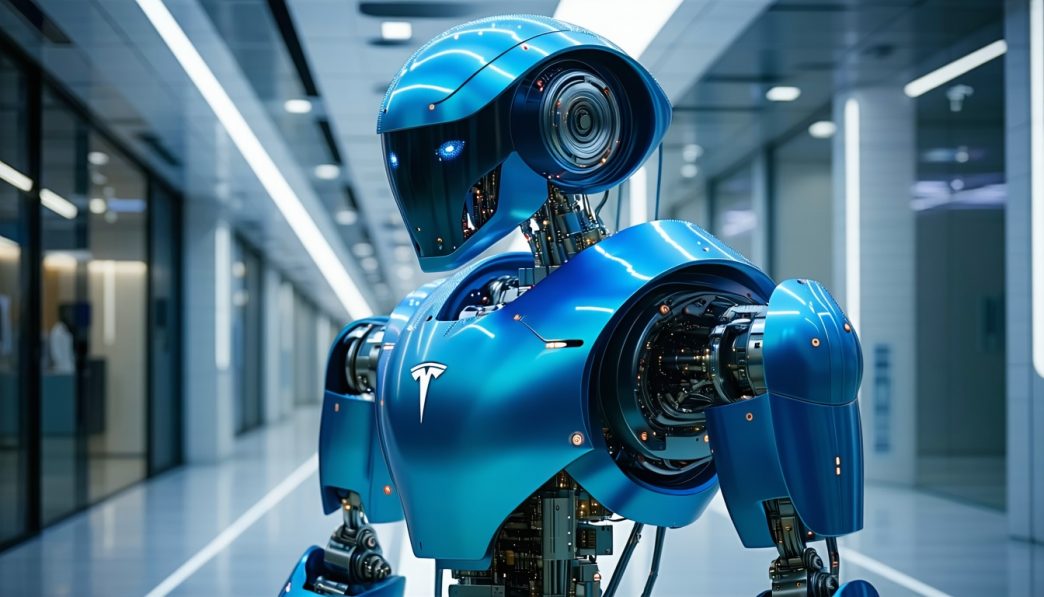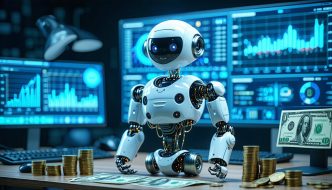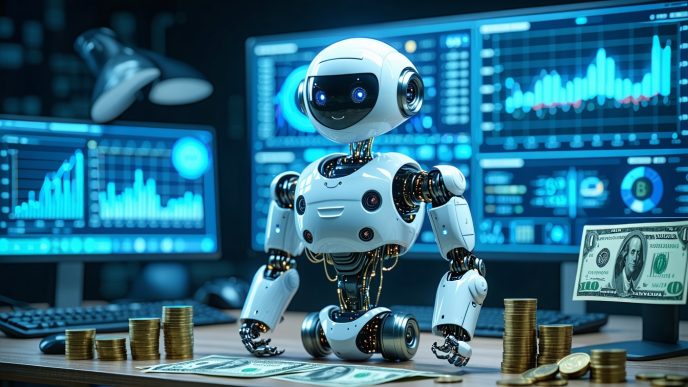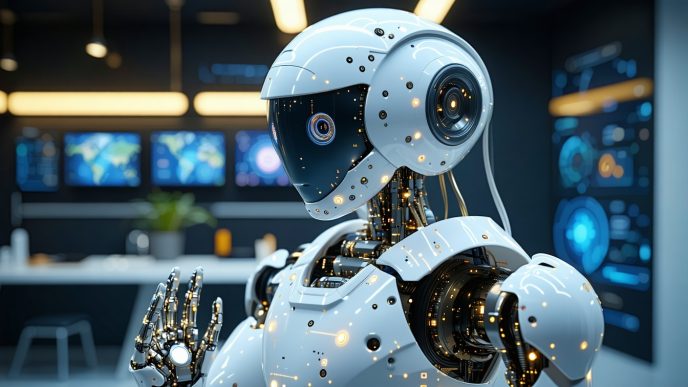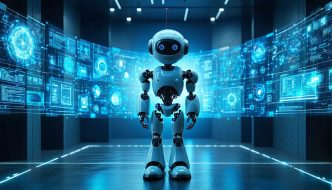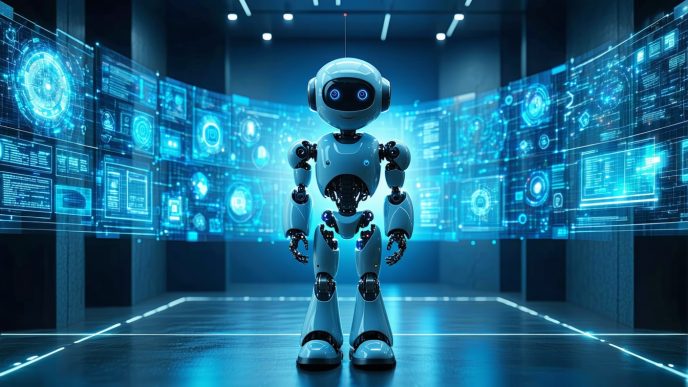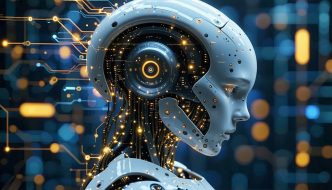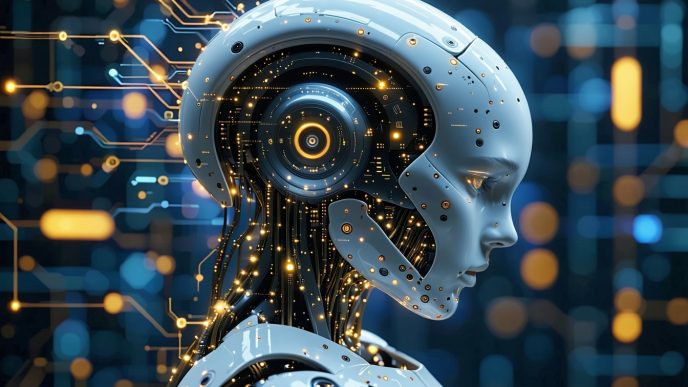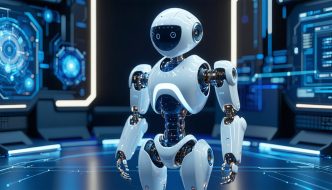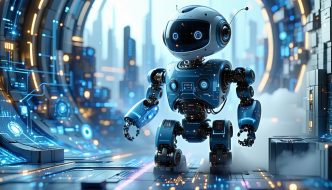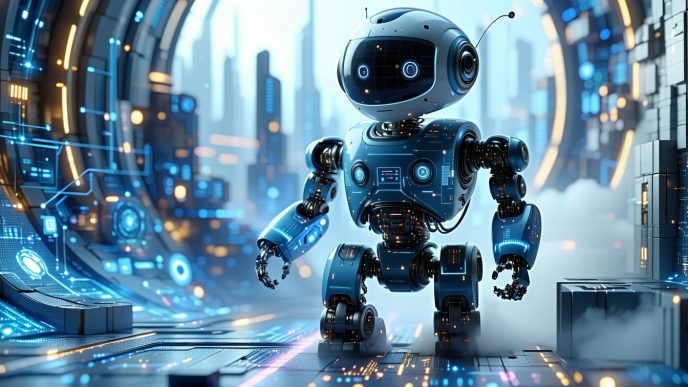Tesla’s Humanoid Robot: Optimus
Introduction to Tesla’s Optimus Robot
The Tesla Optimus Robot, recently introduced by the automaker known for its advancements in electric vehicles and technology, represents a significant leap in the field of robotics. Designed to operate autonomously, this humanoid robot aims to assist in various tasks, potentially transforming multiple sectors through improved efficiency and productivity. Equipped with sophisticated technologies, the Optimus robot is poised to change the way humans interact with machines.
The Concept Behind the Tesla Optimus Robot
The core concept of the Tesla Optimus robot revolves around the idea of providing assistance to humans in everyday tasks. It is structured to resemble a human form, allowing it to navigate environments designed for people effectively. The challenge lies not only in the design but also in creating an interface where the robot can understand and respond to human commands intuitively.
Tesla’s approach to the Optimus robot incorporates advanced algorithms and AI technology, enabling it to learn and adapt to new situations. This flexibility is essential for applications in industries such as healthcare, logistics, and home assistance. By harnessing insights from the capabilities of other robotic systems, such as those found in humanoid robots for home use, Tesla plans to make the Optimus robot a versatile tool for various environments.
Table: Concept Overview of Tesla’s Optimus Robot
| Feature | Description |
|---|---|
| Design | Humanoid form for natural interaction |
| Primary Function | Assist in daily tasks |
| Technology | AI-driven with advanced learning capabilities |
| Applications | Healthcare, logistics, home assistance |
The introduction of the Tesla Optimus robot highlights the potential of humanoid robots in reshaping daily life and work. By blending advanced technology with practical functionality, Tesla aims to set new standards for robotics and automation in the future. For further exploration of different robotic models, consider checking out articles on Agility Digit Robot or Sanctuary AI Phoenix for comparisons of humanoid capabilities.
Design and Features
The design and features of the Tesla Optimus robot embody the latest advancements in robotics. With a focus on aesthetics and functionality, Tesla aims to create a humanoid that is both practical and visually appealing.
Physical Appearance of Tesla’s Optimus
The Tesla Optimus robot boasts a sleek and modern design. Its humanoid shape is intentional, aiming to mimic human movements and dexterity.
Key aspects of the physical appearance include:
| Feature | Description |
|---|---|
| Height | Approximately 5’8″ (173 cm) |
| Weight | Around 125 lbs (57 kg) |
| Color | Predominantly white with black accents |
| Mobility | Designed for agile movement |
| Manipulators | Advanced robotic hands with multiple degrees of freedom |
The design not only prioritizes aesthetics but also ensures that the robot can effectively interact with human environments. Its humanoid structure allows it to navigate spaces designed for people, enhancing its potential applications in various sectors.
Key Features and Capabilities of the Optimus Robot
Tesla’s Optimus is equipped with several cutting-edge features and capabilities. These innovations aim to enhance its functionality and utility in real-world applications.
| Capability | Description |
|---|---|
| Intelligent Navigation | Utilizes advanced algorithms for obstacle avoidance and pathfinding. |
| Fine Motor Skills | Capable of performing delicate tasks with precision, similar to human hands. |
| AI Integration | Embeds artificial intelligence for improved decision-making and interaction. |
| Energy Efficiency | Optimized power consumption to extend operational time. |
| Voice Recognition | Equipped with advanced voice interfaces for communication. |
These features make the Tesla Optimus robot suitable for various roles, including assistance in homes, workplaces, and more specialized tasks in industries like healthcare and logistics. For more information on the potential uses, refer to humanoid robots for home use and humanoid robots in healthcare.
Overall, the design and features of the Tesla Optimus reflect a forward-thinking approach to robotics, with an emphasis on seamless integration into everyday life and diverse applications.
Technology and Innovation
Advanced Technologies Utilized in Optimus
The Tesla Optimus robot incorporates several advanced technologies designed to enhance its functionality and interactions with humans. These technologies enable it to operate efficiently in a variety of environments.
| Technology | Description |
|---|---|
| AI and Machine Learning | Tesla utilizes sophisticated algorithms to enable Optimus to learn from its surroundings, improving its decision-making capabilities. |
| Advanced Sensors | A range of sensors, including cameras and LiDAR, provide spatial awareness and real-time data processing. This allows for effective navigation and obstacle avoidance. |
| Robotics Software | Optimus operates on an advanced software platform that integrates various functionalities, including mobility, object recognition, and communication. |
| Energy Management | Optimus is designed with energy efficiency in mind, utilizing smart power management systems to optimize battery life and performance. |
How Tesla Plans to Implement Robotics in Optimus
Tesla has a comprehensive roadmap for implementing robotics in the Optimus project. The focus is on creating a robot that not only performs tasks effectively but also integrates smoothly into everyday life.
-
Task Automation: Optimus is tailored to handle repetitive tasks, allowing humans to focus on more complex activities. This is particularly beneficial in settings like warehouses or homes, where efficiency is key.
-
Human Interaction: Optimus is designed to understand and respond to human commands. This includes both verbal and non-verbal cues, enabling a more natural interaction. For further exploration of voice interfaces in robots, see our article on voice interfaces in humanoid robots.
-
Integration with Tesla Technology: Leveraging Tesla’s existing technology framework, Optimus can connect with smart devices and systems. This integration facilitates enhanced functionality, making it adaptable for various applications across industries.
-
Continuous Learning and Upgrades: Tesla aims for Optimus to evolve over time through software updates and enhancements. This adaptability ensures that the robot remains effective and that its functionality improves as new technologies emerge. Insights into AI models used in humanoid robots can be found in our article on ai models in humanoid robots.
Through these strategies, Tesla envisions the Optimus robot as a transformative solution that will not only streamline tasks but also revolutionize how humans interact with technology.
Functionality and Applications
The Tesla Optimus robot is designed to perform a variety of functions that could revolutionize how humans interact with technology. This humanoid robot aims to assist in daily tasks, enhance workplace efficiency, and ultimately reshape the workforce landscape.
Planned Functions and Uses of the Optimus Robot
Tesla’s Optimus robot is expected to have several capabilities, making it a versatile tool in multiple environments. Some of the planned functions include:
| Function | Description |
|---|---|
| Household Chores | Performing tasks such as cleaning, cooking, and organizing. |
| Manual Labor | Assisting in physical tasks in various workplaces. |
| Companionship | Providing social interaction and support for individuals. |
| Delivery Tasks | Facilitating the delivery of items within a given space. |
| Data Processing | Executing complex calculations and managing information. |
| Customer Service | Engaging with customers in retail or service sectors. |
These functions highlight the potential of the Tesla Optimus robot to integrate into everyday life, assisting with both menial tasks and more complex responsibilities.
Potential Impact of Optimus in Various Industries
The implications of integrating Tesla’s Optimus robot span across different sectors, offering transformative benefits.
Healthcare
Robots like Optimus could play a vital role in healthcare settings by aiding in patient care, administering medication, and streamlining administrative tasks. The introduction of humanoid robots in healthcare could alleviate some burdens on staff and improve patient outcomes.
| Sector | Potential Applications |
|---|---|
| Healthcare | Patient assistance, administrative support |
| Education | Interactive learning tools, tutoring |
| Logistics | Efficient inventory management, order fulfillment |
| Hospitality | Enhancing customer service, room service delivery |
| Manufacturing | Assembly line support, quality control |
Education
In educational settings, the Optimus robot could serve as a teaching assistant, engaging students in interactive learning experiences and providing personalized tutoring.
Logistics
In the logistics sector, Optimus could improve efficiency by managing inventory and assisting in the fulfillment of orders, potentially transforming supply chain management.
The potential for Tesla’s Optimus robot stretches far beyond simple tasks, aiming to enhance productivity and enrich human experiences across various industries. For insights into how humanoid robots are being utilized in specific settings, consider reading about humanoid robots in healthcare and humanoid robots for home use.
Performance and Efficiency
Efficiency Levels and Power Management of Optimus
The Tesla Optimus robot is designed with advanced efficiency levels and sophisticated power management strategies. Optimizing energy use is vital for enabling long-duration operations while maintaining performance.
The following table summarizes expected energy consumption and efficiency metrics for the Tesla Optimus robot under different operating conditions:
| Operating Mode | Estimated Power Consumption (W) | Efficiency Rating (%) |
|---|---|---|
| Idle | 15 | 95 |
| Basic Tasks | 50 | 85 |
| Complex Maneuvers | 100 | 75 |
| Standby | 10 | 98 |
Power management systems in Optimus will help regulate energy consumption, extend battery life, and optimize operational effectiveness. The robot is anticipated to feature a dynamic battery system that adjusts power usage based on the task’s complexity, a crucial element for long-term usability.
Performance Metrics and Expected Results from Optimus
Performance metrics for the Tesla Optimus robot indicate its potential to excel in various functional areas. These metrics will help assess its operational capability and effectiveness in real-world scenarios.
The following table presents some anticipated performance metrics for Optimus:
| Performance Criteria | Expected Performance Level |
|---|---|
| Maximum Load Capacity | 60 kg |
| Maximum Speed | 5 km/h |
| Operating Temperature Range | -10°C to 40°C |
| Battery Life per Charge | 8 hours |
| Response Time for Commands | 0.3 seconds |
Optimus is designed with versatility in mind, with applications ranging from assistance in domestic tasks to potential use in industrial settings. By focusing on robust performance metrics, Tesla aims to ensure that the Optimus robot can efficiently meet the diverse needs of its users.
For further insights into the applications of robots like Optimus, explore our articles on humanoid robots for home use and humanoid robots in logistics.
Safety and Ethical Considerations
As Tesla develops its humanoid robot, Optimus, safety and ethical implications are central focus areas. Ensuring that this technology operates securely and responsibly is key to its successful implementation.
Safety Features Incorporated in Optimus
Safety features are critical in any humanoid robot, particularly in one designed for interaction with humans. Tesla’s Optimus incorporates several safety mechanisms to protect users and itself during operation. Some of these features include:
- Collision Detection: Optimus is equipped with sensors that allow it to detect obstacles in its path, preventing collisions and injuries.
- Emergency Stop Function: Users can engage an emergency stop feature to cease all operations immediately, ensuring safety during unpredictable situations.
- Soft-Touch Materials: The exterior of Optimus may utilize soft-touch materials to minimize injury risk during accidental contact.
- Motion Limiters: To reduce the risk of harm, motion limiters may be integrated, controlling the speed and range of movement.
| Safety Feature | Description |
|---|---|
| Collision Detection | Sensors to prevent collisions |
| Emergency Stop | Immediate halt of operations |
| Soft-Touch Materials | Reduces injury risk upon contact |
| Motion Limiters | Controls speed and range of movement |
Ethical Concerns Surrounding the Use of Humanoid Robots
With the rise of humanoid robots like Optimus, ethical considerations must be addressed. Concerns surrounding the use of such technology include:
- Job Displacement: The introduction of humanoid robots may lead to job losses in sectors where tasks can be automated.
- Privacy Issues: As robots become more integrated into daily life, concerns regarding data collection and surveillance arise.
- Human Interaction: The potential for robots to replace human contact raises questions about social implications and emotional connections.
- Accountability: Determining who is responsible for a robot’s actions, particularly if they cause harm or malfunction.
| Ethical Concern | Explanation |
|---|---|
| Job Displacement | Automation replacing human jobs |
| Privacy Issues | Data collection and surveillance |
| Human Interaction | Impact on social relationships |
| Accountability | Responsibility for robot actions |
These safety features and ethical considerations highlight the importance of careful planning and design in the development of the Tesla Optimus robot. Addressing these issues will be crucial as it seeks to integrate into various sectors, including humanoid robots for home use, healthcare, and more.
Future Developments
Tesla’s Roadmap for Optimus
Tesla has outlined a detailed roadmap for the development of the Optimus robot, focusing on incremental advancements and breakthrough features. The company aims to enhance Optimus’s capabilities over a series of stages, targeting both functionality and safety. Below is a summary of key milestones in Tesla’s roadmap for the Optimus project:
| Development Stage | Timeline | Goals |
|---|---|---|
| Prototype Development | 2023 | Initial testing and refinement of basic movements and functionalities. |
| Functional Testing | 2024 | Implementation of core tasks, such as object handling and limited autonomous navigation. |
| User Feedback Cycle | 2025 | Gathering insights from early adopters and addressing usability concerns. |
| Full-Scale Production | 2026 | Launching the ideal iteration of Optimus for commercial use across industries. |
| Advanced Features | 2027 and beyond | Integration of AI models for enhanced decision-making and adaptability. |
Tesla plans to integrate feedback at each stage to ensure Optimus meets consumer expectations while continuously improving. For insights on AI’s role in humanoid robots, see our article on neuralink and humanoid integration.
Predictions and Speculations About Future Versions of Optimus
The future versions of the Tesla Optimus robot hold exciting possibilities according to industry experts. Analysts predict enhancements in design, functionality, and user interface in the next iterations:
-
Enhanced Interactivity: Future models may feature advanced voice interfaces to improve communication with users. This could make interactions more intuitive and engaging. More on this can be found in our article on voice interfaces in humanoid robots.
-
Increased Autonomy: Future versions are expected to utilize machine learning to understand and anticipate user needs better, thus enabling a higher degree of autonomy in everyday tasks.
-
Improved Safety Mechanisms: With ongoing concerns surrounding humanoid robot safety, later iterations could incorporate new safety systems to identify and respond to potential hazards. Details on the current safety features can be viewed in our prior discussions on humanoid robot safety systems.
-
Customized Robots: As technology evolves, Tesla might offer customizable features that allow users to personalize their Optimus robots according to individual preferences and specific household needs. Explore more about this aspect in our article on humanoid robot customization.
-
Specialized Applications: Future versions could focus on specific sectors, such as healthcare, logistics, and customer service, thereby diversifying their applications and functionalities. Insights on their roles in these fields can be found in our piece on humanoid robots in healthcare and humanoid robots in logistics.
As Tesla pioneers the development of humanoid robots, Optimus is positioned to become a cornerstone of automation and personal assistance in everyday life. The advancements in upcoming versions will likely reshape how humans interact with technology.
